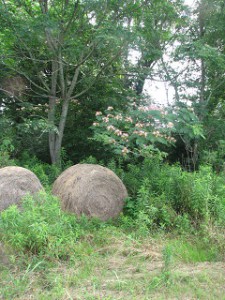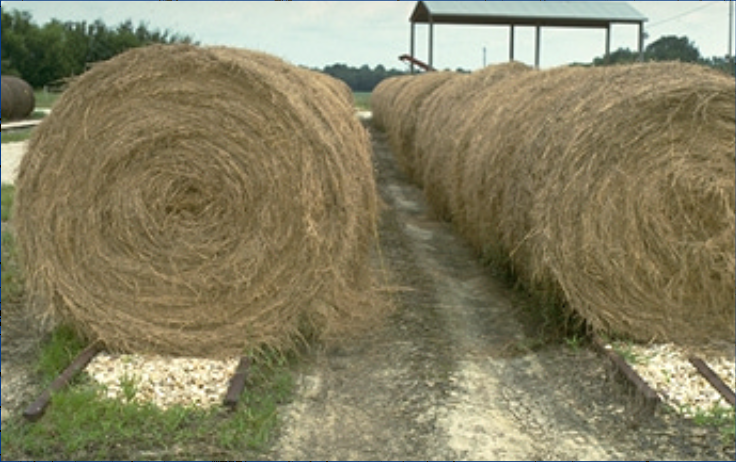
Just because you don’t have a barn doesn’t mean you have to leave your hay unprotected. Credit Jed Dillard, UF/IFAS
When large round hay bales came along, those of us who had cut our agricultural teeth on stacking small square bales thought we’d never need to put hay bales in a stifling hot barn again. Unfortunately, financial reality intervened.
As Mark Mauldin’s article, Minimize Hay Losses to Save Money pointed out, large round bales stored outside on the ground can lose up 25% of their dry matter content in a year. At the most recently quoted hay price in south Alabama of $114/ton, that increases the cost per ton of stored hay to $152/ton even in the unlikely event the hay loses no quality. Quality losses increase the costs. As Don Ball, Auburn Forage Specialist said many times, ” You’re paying for a hay barn, whether you build it or not.”
Even with such dire economic consequences, there are still more producers with round balers than hay barns. If you’re one of those now, you’ll likely still be one after you put up your first cutting of hay this year. Maybe even after you put up the last cutting.
Good news! You still have options to reduce your losses. It just takes some changes in what a lot of folks still do when they store hay outside. The first and most important step is to figure out a method to keep bales from making contact with the soil. Fence posts, pallets, or old tires can keep bale bottoms drier and reduce loss.

A relatively inexpensive and effective storage technique is to place hay on rock pads. A good rock pad keeps bales off the soil, and also provides all weather support for equipment. Rocks 1 to 3 inches in diameter should be piled 4 to 8 inches deep. This size rock traps no water and effectively channels water away. Source: MINIMIZING LOSSES IN HAY STORAGE AND FEEDING
Even if you aren’t willing or able to make the investment to keep hay off of the ground, there are still options to protect hay stored on the ground. A little attention to some simple issues can make a difference. Here’s how.
- Move your round bales to your storage location soon as possible after baling. Thatch formation is a what helps keep moisture out. Once thatch is formed, moving the bale disrupts the thatch, requiring its reformation to keep out moisture. More good hay is required to replace it.
- Put the bales in long north-south rows. The north-south orientation allows maximum drying. Once hay is baled, moisture is its enemy.
- Butt the bales end to end. Tightly! End to end bales will thatch as a single roll and reduce the loss on the ends. Reducing end spoilage by two inches per end per roll saves a four foot wide bale of hay for every thirteen rolls in the line.
- Leave space between the rows of rolls, preferably three feet. Again, this allows hay to dry out ASAP after dew or rain fall.
- Run the rows up and down the slope, not across it, to minimize runoff blockage. Rows stacked across the slope will trap moisture as it moves downslope.
- Don’t store round rolls under trees! Everybody wants to leave as much hayfield in grass as possible, but trees prevent drying.
- Make sure bale stacks are not in areas subject to flooding. Sounds obvious, but in the last year, we’ve seen flooding in lots of new places.
- Leave the top of the hill for lightning strikes. Florida is lightning country, and you don’t want your hay supply going up in smoke. You’ll be losing enough to other weather factors.
For More information on hay storage techniques, download: MINIMIZING LOSSES IN HAY STORAGE AND FEEDING, or contact your County Extension Agent.
- Nutrient Management for Vegetable Growers in the Florida Panhandle - April 4, 2025
- 2025 Tri-State Fruit & Vegetable Conference Highlights & Presentation Links - January 31, 2025
- Save the Date: 2025 Tri-State Fruit & Vegetable Conference- January 28 - November 22, 2024
